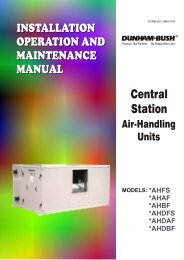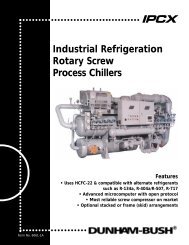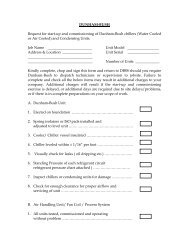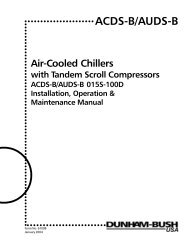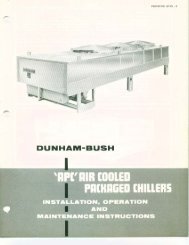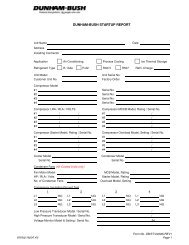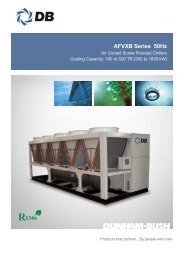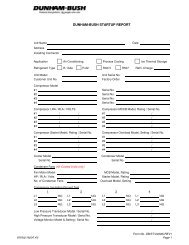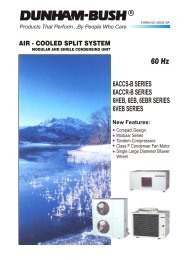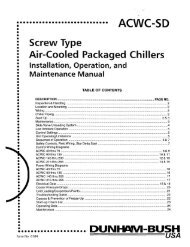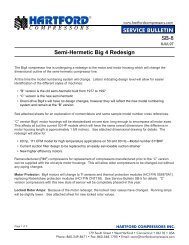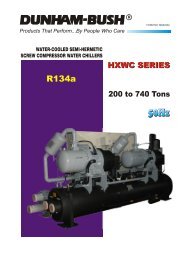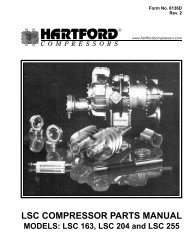CS2 Central Station Air Handlers.pdf - Dunham-Bush Americas
CS2 Central Station Air Handlers.pdf - Dunham-Bush Americas
CS2 Central Station Air Handlers.pdf - Dunham-Bush Americas
You also want an ePaper? Increase the reach of your titles
YUMPU automatically turns print PDFs into web optimized ePapers that Google loves.
Water Coils Exposed To FreezingTemperaturesWater coils exposed to freezing temperatures must beprotected from freeze-up by either adding an anti-freezesolution to the coils or by proper draining of the coils.<strong>Dunham</strong>-<strong>Bush</strong> coils are circuited to avoid trappedcircuits. However, because of the serpentine nature ofthe circuiting, it is almost impossible to adequately drainthe coils by gravity alone. Particularly on longer finnedlength coils, even a fraction of a degree deviation froma horizontal plane can lead to water being trappedwithin the serpentine. Water that has failed to drainfrom a single tube, or even part of a tube, can causethe tube to rupture upon freezing.Draining Coils Using Supplemental <strong>Air</strong>BlowerIdeally, a blower capable of delivering 150 CFM of airat approximately 40-50 inches of water or more shouldbe used. Some small air compressors, while deliveringhigher pressure, probably will not deliver sufficientvolume of air and this is equally as important.1. Drain the coil by gravity after opening the supply,return, vent and drain connections.2. Connect the blower to the larger connection that isat the greatest elevation. The small vent or drainconnection on the header to which the blower isconnected should be closed. Refer to Figure 1 fortypical hook-up during the blow-out operation. It ishelpful to tap the coil casing along the length of thecoil during the draining process. The blower shouldbe operated until no moisture can be detected leavingthe coil. Then, shut the blower off and permit thecoil to stand for a few minutes. This will permit themoisture that has adhered to the walls to accumulate.Then the blowing out operation should be repeated.Ideally, the coil should be permitted to stand twentyfour(24) hours and then be blown out again.3. Leave all connections open until coil is put intooperation.Installation Of Anti-freeze SolutionA second way to prevent a coil freeze-up is to add ananti-freeze to coil such as industrially inhibited glycol.The coil should be valved off so that only the coil wouldhave anti-freeze added to it. The most positive way toassure the mixing of the anti-freeze is to make a runaroundloop with a circulating pump.1. Open all connections and drain the coil as thoroughlyas possible.2. The anti-freeze solution should be added to the coiland circulated through the coil until the solution isthoroughly mixed and all air is purged from the coil.The air vent should be opened during the fillingoperation and cracked during the pumping operationto accomplish this. When the solution has circulatedfor 15-20 minutes, the concentration of the solutionshould be checked with a suitable hydrometer. Ifthe concentration is low, add more glycol and operatethe pump again. Refer to Figure 2 for a typical pipingdiagram.3. The anti-freeze solution may then be left in the coilsor drained and used to flush another coil. Theconcentration must be checked for each coil flushed.The addition of anti-freeze to a system exposed tofreezing conditions may be necessary if the system mustbe operational at a moment’s notice. This affects thechiller and coil performance and must be taken intoconsideration when selecting components.NOTE:Most anti-freeze solutions will be furnished with a chartfor concentration at freezing point. It is also importantto be certain that the anti-freeze solution used is notcorrosive to the tubing. If this information is notavailable, consult <strong>Dunham</strong>-<strong>Bush</strong>.Figure 1Blower Supplemented Coil DrainingFigure 2Typical Piping Diagram forAdding Anti-Freeze SolutionHorizontal <strong>Air</strong> FlowBlower*VentAIRFLOWOutVentAIR FLOW*DrainOpen DuringBlowing OperationVertical <strong>Air</strong> Flow*VentAIR FLOWGLYCOLSOLUTIONCirculatingPumpDrainInOpen DuringBlowing OperationBlower*Drain7



